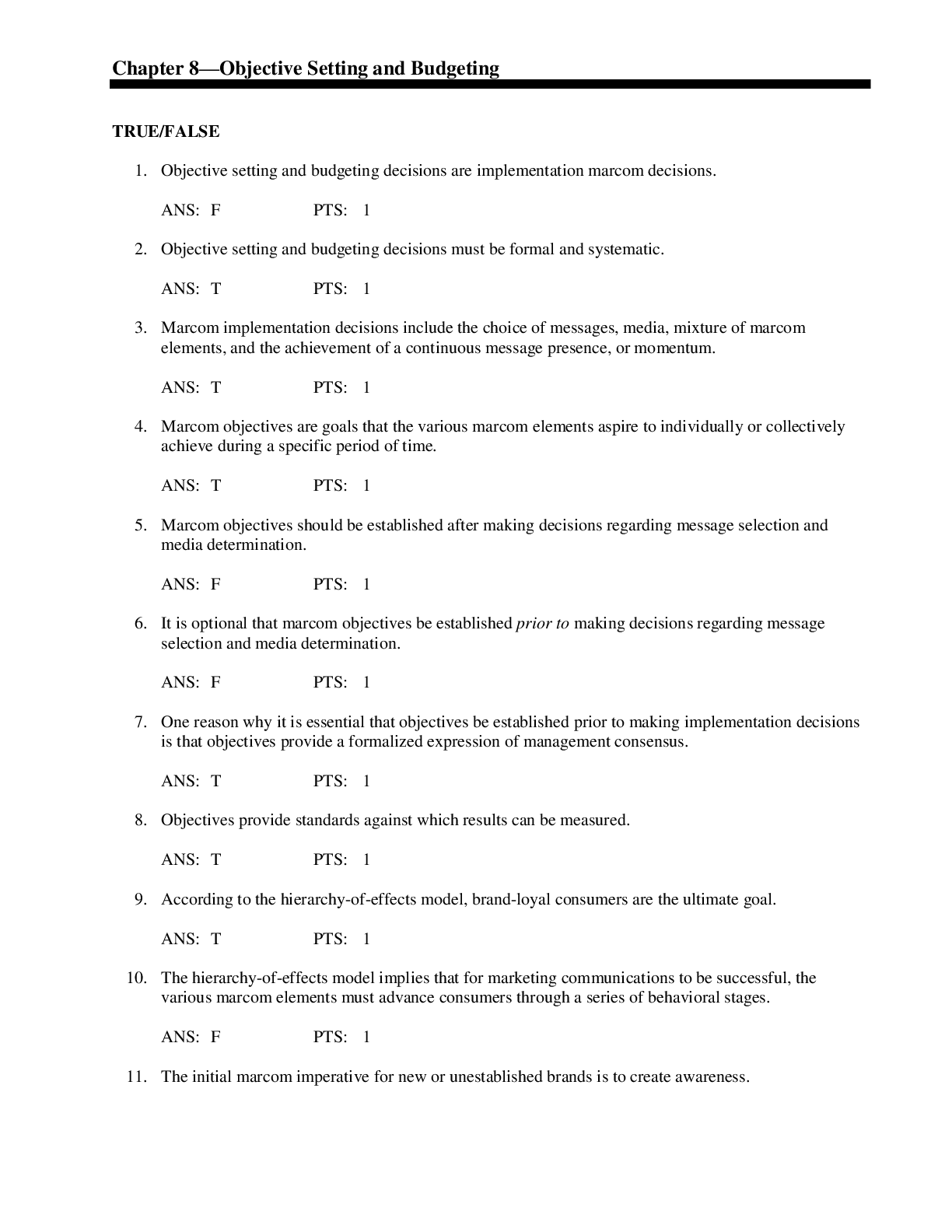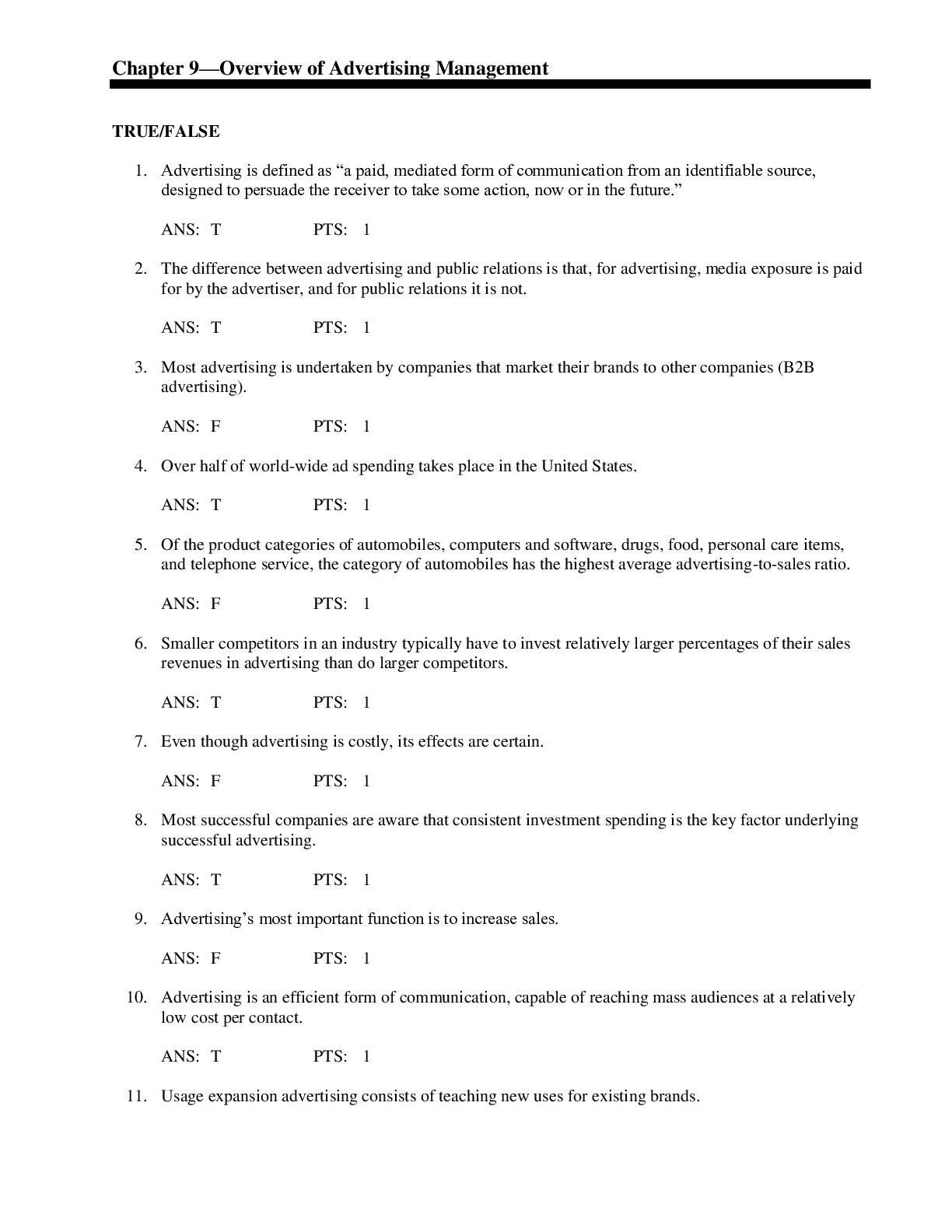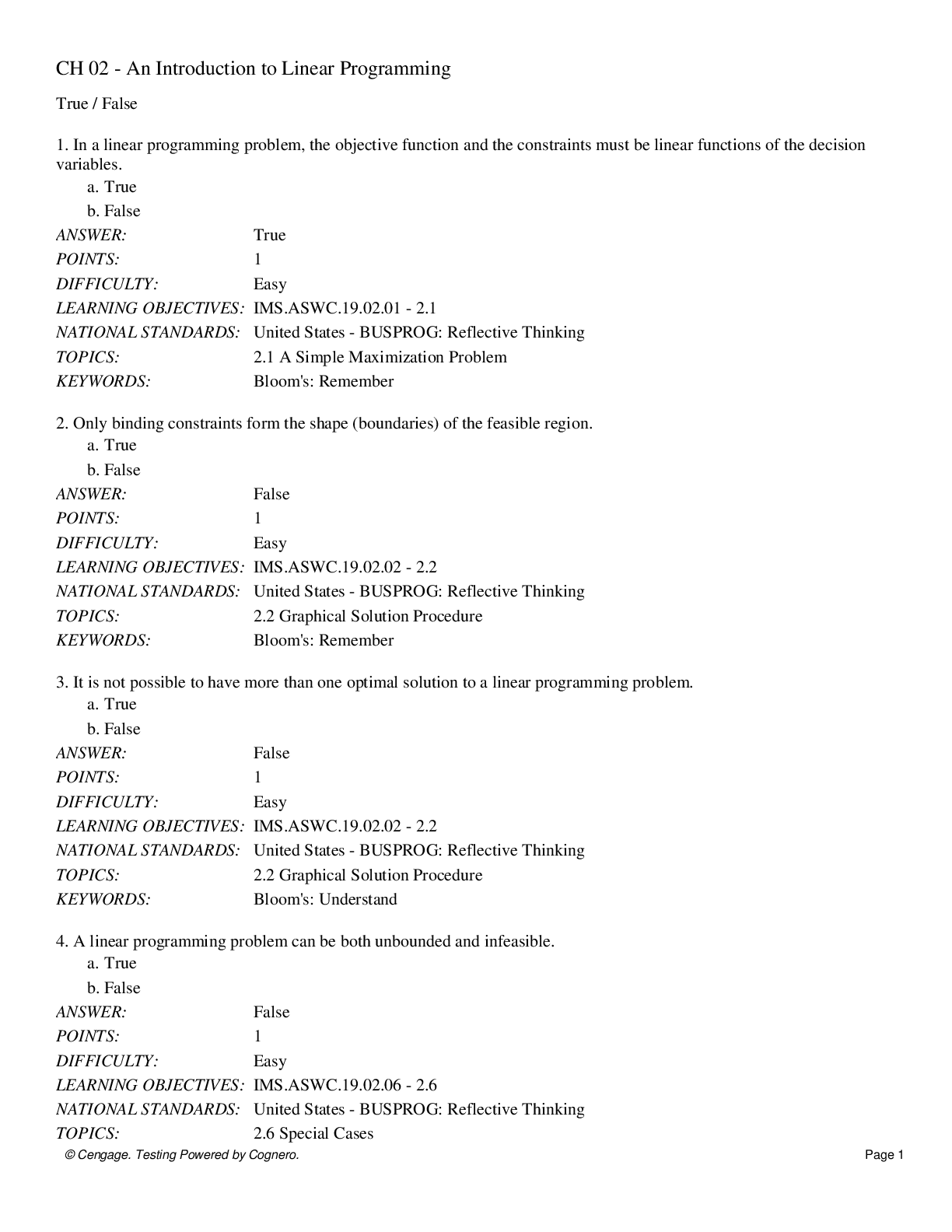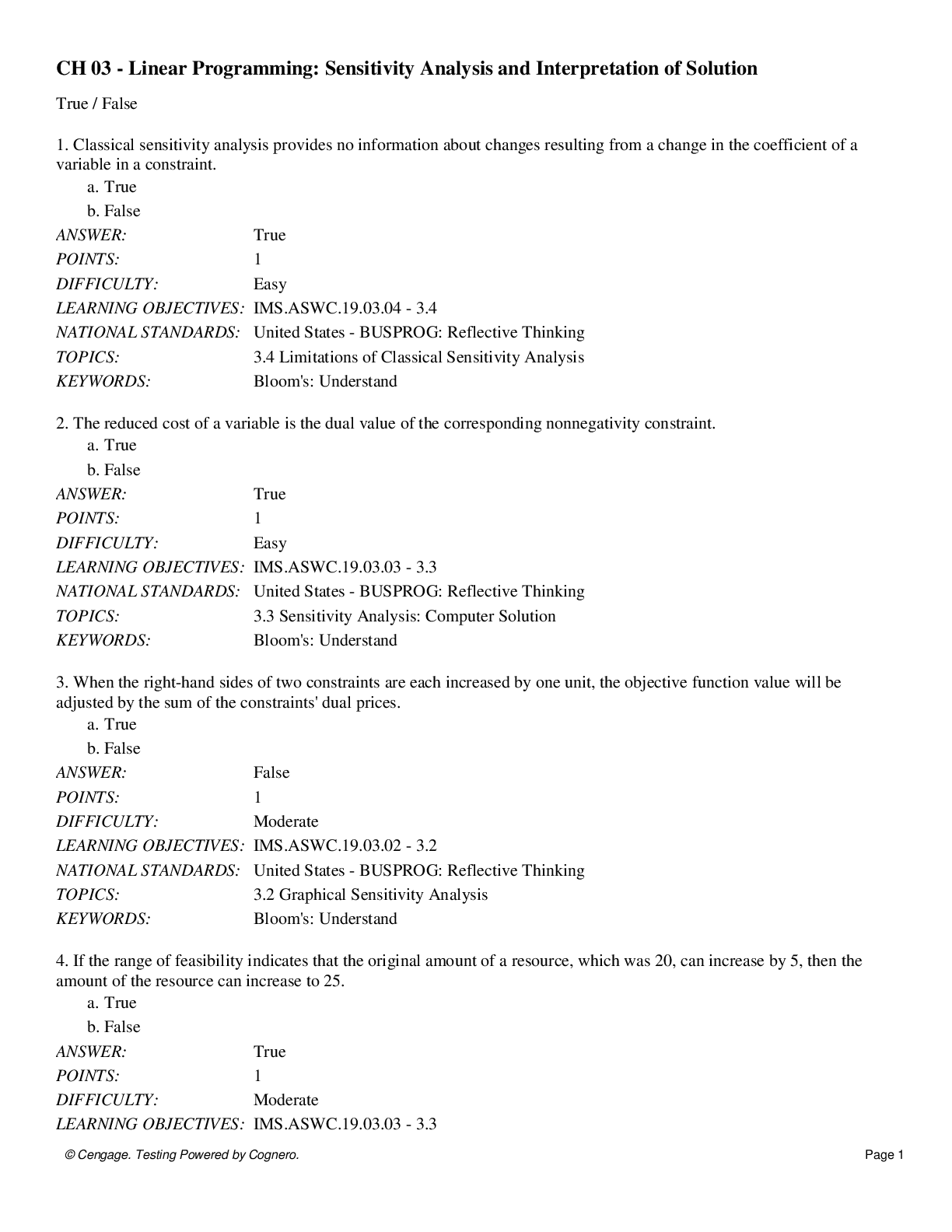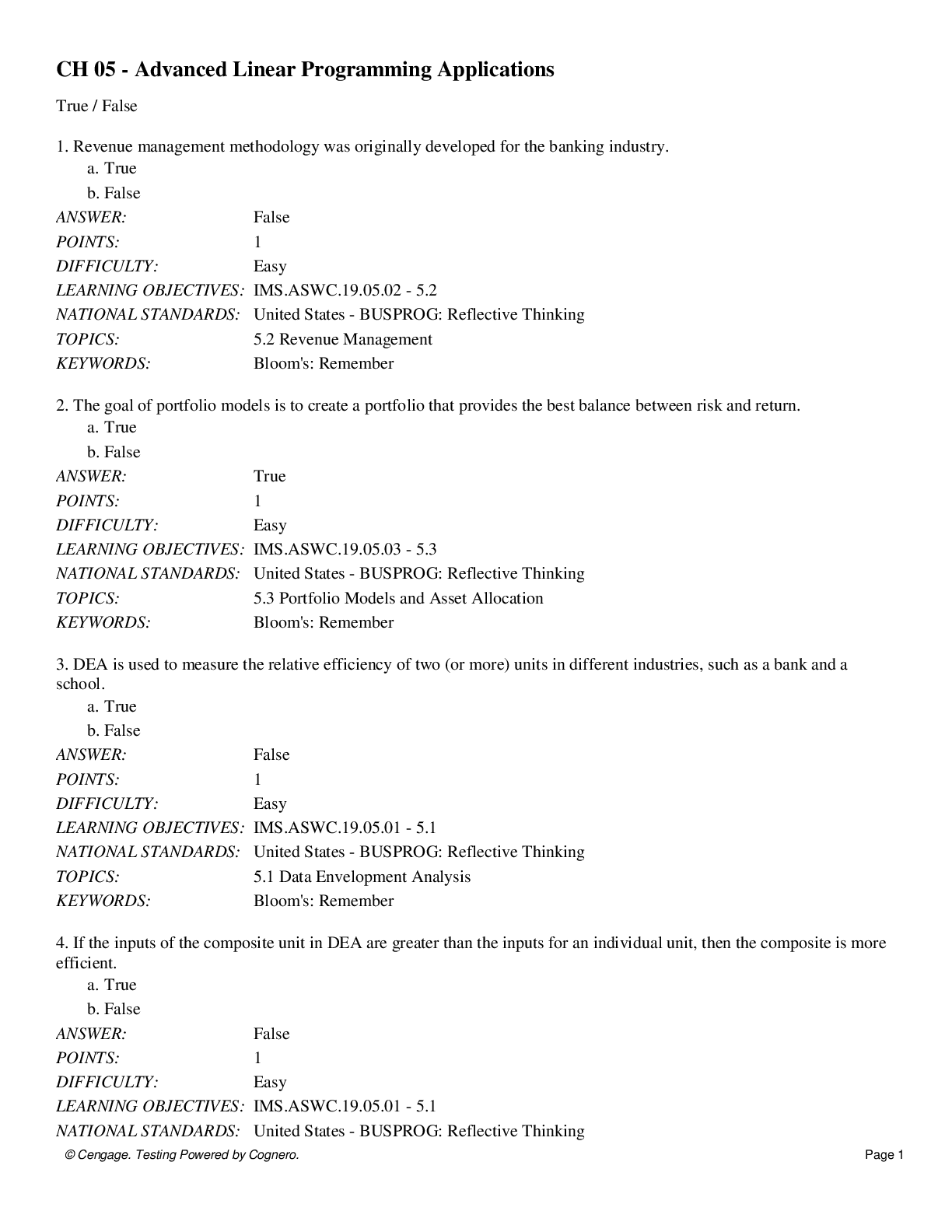Pathophysiology > QUESTIONS & ANSWERS > Neurosurgery Practice Questions and Answers (201-300) (All)
Neurosurgery Practice Questions and Answers (201-300)
Document Content and Description Below
201. The best-characterized glutamate-containing neurons are found in the A. Purkinje cells of the cerebellum. B. pyramidal cells of the cerebral cortex. C. pyramidal cells of the hippocampus. D. ... septal region. E. lateral entorhinal cortex. 202. All of the following statements are true of nuclear chain fibers EXCEPT: A. They receive group Ia primary afferent fibers. B. They receive group II secondary afferent fibers. C. They are associated with flower spray endings. D. They are associated with static gamma efferent fibers. E. They respond to muscle tension. 203. Patients who continue to display mental status changes after correction of diabetic ketoacidosis should be investigated for A. cysticercosis. B. histoplasmosis. C. Lyme disease. D. mucormycosis. E. hydatid disease. 204. Which of the following is FALSE with regard to shunt nephritis? A. It is a well-described complication of VP shunts. B. It is due to deposition of immune complexes in the glomeruli of kidneys. C. The diagnosis is suspected with hematuria, elevated erythrocyte sedimentation rate (ESR), and decreased complement levels. D. Proper treatment entails removing the entire shunt. E. There is an elevated peripheral WBC count. 205. Regarding DNET, which of the following is FALSE? A. Male predominance has been noted. B. It is a surgically curable cause of partial seizures. C. There is an abundance of mitoses with no necrosis. D. It is a mixed glial and neuronal neoplasm. E. It shows on CT scans as a hypodense pseudocystic lesion. 206. Which of the following is the most appropriate next step in management of a hypertensive patient who sustained recurrent falling episodes and complains of headache with the MRI findings shown here? A. Transsphenoidal resection B. Bromocriptine C. Angiography D. Ophthalmologic evaluation E. Transcranial resection 207. The saccule sends fibers to the _______vestibular ganglion which project to the _______vestibular nucleus. A. Superior, superior B. Superior, inferior C. Inferior, superior D. Inferior, inferior E. None of the above 208. Which of the following tracts traverse the restiform body? A. Olivocerebellar B. Reticulocerebellar C. Dorsal spinocerebellar D. All of the above E. None of the above 209. A favorable prognosis in neuroblastomas is related to A. n-Myc amplification. B. 1p deletion. C. TrkA expression. D. older age. E. None of the above 210. For microvascular decompression in a patient with trigeminal neuralgia, the first bur hole is best placed at the A. mastoid tip. B. key hole. C. asterion. D. bregma. E. lambda. 211. The definitive marker for cholinergic neurons is A. acetyl CoA. B. acetylcholinesterase. C. choline acetyltransferase. D. choline. E. sensitivity to hemicholinium-3. 212. Tanycytes are most likely to be found in A. the wall of the third ventricle. B. a high-grade glioma. C. a low-grade glioma. D. the cauda equina. E. None of the above Match the statement with the appropriate structure on the diagram: 213. Genitofemoral nerve 214. Innervates the sartorius muscle 215. Enables leg abduction 216. Meralgia paresthetica 217. The vagus nerve leaves the medulla A. between the pyramid and the olive. B. between the olive and the inferior cerebellar peduncle. C. from the same sulcus as CN XII. D. from the dorsomedial sulcus. E. from none of the above. 218. Bilateral damage to the medial basal occipitotemporal cortex results in A. astereognosis. B. prosoprognosia. C. alexia without agraphia. D. auditory agnosia. E. autotopagnosia. 219. Neuroblastomas may present with A. spinal cord compression. B. Ondine’s curse. C. opsoclonus syndrome. D. diarrhea. E. All of the above 220. One of the most significant prognostic indicators for successful prolactinoma surgery is A. the results of the Goldman perimetry field. B. being male. C. the preoperative prolactin level. D. the age of the patient. E. being female. 221. Nitric oxide synthase is responsible for A. conversion of R-arginine into nitrous oxide (NO). B. conversion of citrulline into NO. C. production of NO and L-arginine. D. production of NO and citrulline. E. None of the above 222. Which Rexed lamina is homologous to the spinal trigeminal tract? A. I B. II C. III and IV D. VII E. IX 223. The most common presentation of vein of Galen malformation in the neonate is A. an intracranial bruit with heart failure. B. subarachnoid hemorrhage. C. hydrocephalus. D. developmental delay. E. ocular symptoms. 224. Which of the following associations based on this MRI scan is FALSE? A. Subarachnoid hemorrhage B. Progressive ascending paraplegic syndrome C. The definitive therapy is microsurgical elimination. D. Tendency to bleed in elderly patients E. It may represent a vascular anomaly. 225. The arcuate eminence is the bony landmark of A. the superior petrosal sinus. B. the superior semicircular canal. C. the middle meningeal artery. D. the vein of Labbé. E. None of the above 226. Which of the following is true of the medial posterior choroidal artery? A. It is a branch of the posterior cerebral artery. B. It supplies the choroid plexus of the third ventricle. C. It supplies the choroid plexus of the lateral ventricles. D. All of the above E. None of the above 227. The calamus scriptorius can be found A. in the third ventricle. B. in the fourth ventricle. C. in the lateral ventricle. D. at the cauda equina. E. in none of the above. 228. Brain waves that are characteristic of deep sleep and have a frequency of 1 to 3 per second are A.α waves. B.β waves. C. theta waves. D. delta waves. E. None of the above 229. Which cranial nerves innervate muscles that attach to the styloid process? A. VII, IX, X B. IX, X C. IX, X, XII D. VII, X E. VII, IX, XII 230. The sagittal vertical axis offset is a measure of sagittal balance performed by using the following: A. C7 plumb line B. Cobb angle C. Pelvic tilt D. Sacral slope E. None of the above 231. Allodynia is a condition in which A. a painful response is produced by an innocuous mechanical stimulus. B. a painful response is felt in an amputated limb. C. a painful response is felt on the opposite side of the body. D. there is sensitization of spinocerebellar neurons. E. all of the above may occur. 232. The nucleus dorsalis of Clarke corresponds to which Rexed lamina? A. I B. II C. III and IV D. VII E. IX 233. All of the following are true of encephaloceles EXCEPT: A. Occipital encephaloceles are the most common type. B. Frontoethmoidal (sincipital) are the most common type in southeast Asia and among Australian aborigines. C. Parietal encephaloceles are associated with Chiari II malformation in up to one-third of cases. D. Basal encephaloceles are associated with defects along the sphenoid bone. E. Children with basal encephaloceles have a low risk of developing meningitis. 234. On a horizontal section of the brain, the anterior limb of the internal capsule can be found between A. the thalamus and the globus pallidus. B. the caudate nucleus and the corpus striatum. C. the caudate and the thalamus. D. the thalamus and the putamen E. None of the above Match the following structures with their appropriate location on the MRI: 235. Supplementary motor cortex 236. Operculum 237. Premotor cortex 238. Heschl’s gyrus 239. Which of the following are true of the greater occipital nerve? A. It emerges inferior to the inferior obliquus capitis muscle. B. It is accompanied by the occipital artery. C. It is a sensory nerve. D. All of the above E. None of the above 240. Which of the following statements is FALSE regarding arachidonic acid metabolism? A. Aspirin inhibits both cyclooxygenase (COX) isoforms. B. Arachidonic acid is a substrate for production of ceramide. C. Thromboxane synthesis inhibitors lead to depletion of arachidonic acid. D. Arachidonic acid is a substrate for COX I. E. Prostaglandin H2PGH2 is a product of the COX enzyme. 241. The basal ganglia output for eye movements is the A. subthalamic nucleus. B. substantia nigra pars compacta. C. substantia nigra pars reticulata. D. globus pallidus interna. E. globus pallidus externa. 242. Which area receives dorsal roots? A. Dorsal lateral sulcus B. Dorsal intermediate sulcus C. Ventral lateral sulcus D. Dorsal median sulcus E. Ventral intermediate sulcus 243. Which statement is true in the case of a 4-year-old with the MRI scan findings shown here? A. Biopsy is usually indicated to confirm the diagnosis. B. Hyperfractionated radiation therapy has not been shown to improve survival. C. It represents 30% of pediatric CNS tumors. D. There is no proven chemotherapeutic regimen. E. Most lesions will regress spontaneously. 244. Which of the following formulas is correct in terms of the relationship of pelvic tilt (PT), pelvic incidence (PI), and sacral slope (SS)? A.PT = PI + SS B.PI = PT + SS C.SS = PI + PT D.PT = PI − SS E.SS = PI ÷ PT 245. The scan shown here was taken from a patient with a prolactin level of 267 mg/dL. Which of the following is FALSE? A. Men may not seek early attention despite loss of libido and potency, headache, or fatigue. B. When visual loss or disturbing endocrine symptoms are present most seek medical attention. C. A useful endocrine test is determination of the basal serum prolactin level. D. The normal level ranges from 5 to 20 ng/mL. E. When the level of prolactin is normal post-treatment, ovulation and menstruation return in < 50% of women in galactorrhea cases. 246. Increased prolactin is typically seen in all the following physiological states EXCEPT: A. Exercise B. Stress C. Sleep D. Pregnancy E. Delivery 247. With surgical resection of the mass (shown above with Question 245), cure can be achieved in what percentage of patients? A. 10% B. 20% C. 40% D. 70% E. 90% 248. All of the following are true of Lhermitte–Duclos disease EXCEPT: A. It is also called dysplastic gangliocytoma of the cerebellum. B. There is demyelination of granular cell layer of the cerebellum. C. There is thickening of one or more cerebellar folia. D. Calcification and hydrocephalus may occur in this disorder. E. A laminated pattern of folia on T2-MRI scans is suggestive of the disease. 249. Which of the following is consistent with the diagnosis of typical trigeminal neuralgia? A. Unilateral symptoms B. Sensory deficit C. Decreased corneal reflex D. All of the above E. None of the above 250. n-Butyl cyanoacrylate is used for A. cranioplasty. B. endovascular procedures. C. topical wound dressings. D. vasospasm in the ICU. E. spinal fusion. 251. A 24-year-old man is brought into the emergency room after sustaining a motorcycle accident. He has a scalp wound that is bleeding profusely. His eyes open only after his name is loudly called; however, he is confused when asked about the details of the accident. He obeys commands in all extremities. In this case, the GCS score is A. 15. B. 14. C. 13. D. 12. E. 11. 252. The ciliospinal center of Budge can be found at which spinal cord level? A. Midcervical B. Upper thoracic C. Lower thoracic D. Lumbar E. Sacral 253. The serum level of phenytoin is increased by all of the following EXCEPT: A. Cimetidine B. Chloramphenicol C. Valproic acid D. Uremia E. Aspirin 254. Which of the following deficits or findings in lateral medullary syndrome is contralateral to the primary pathology? A. Pain and temperature of the body B. Pain and temperature of the face C. Horner’s syndrome D. Falling E. None of the above 255. Which of the following fractures is most commonly associated with anterior cord syndrome? A. Clay shoveler’s fracture B. Wedge fracture C. Teardrop fracture D. Chance fracture E. None of the above 256. With regard to surgical techniques on pituitary tumors, which of the following is FALSE? A. Lacerations in the gland with attendant subcapsular bleeding make it difficult if not impossible to detect the subtle differences between the normal gland and a small tumor. B. Prolactin microadenomas are usually situated medially in the gland. C. Larger pituitary tumors usually erode the floor of the sella turcica, and in these cases the tumor may extrude into the operative wound upon removal of the floor of the sella and opening of the dura mater. D. Frequently, the pituitary gland is compressed and flattened against the dorsum sellae or diaphragma sellae by tumor. E. Reported incidence of postoperative CSF rhinorrhea is ~3%. 257. All of the following structures are derived from ectoderm EXCEPT: A. Pia B. Dura C. Arachnoid D. Glia E. Ependyma 258. The most common primary tumor of the septum pellucidum is A. meningioma. B. oligodendroglioma. C. astrocytoma. D. ependymoma. E. None of the above 259. Which of the following is the most common conflicting vessel in trigeminal neuralgia? A. AICA B. PICA C. SCA D. Satellite veins E. None of the above 260. The ELANA technique may be helpful in A. vertebrobasilar ischemia. B. controlling ICP C. vasospasm. D. tumor biology. E. None of the above 261. This cervical spine MRI scan demonstrates A. metastatic disease. B. jumped facet. C. burst fracture. D. teardrop fracture. E. epidural abscess. 262. A 64-year-old woman presents to the clinic with a left thalamic arteriovenous malformation (AVM). The lesion appears to be ~5 cm in its greatest dimension. The AVM drains exclusively to the deep venous system via several stenotic veins. How would one best grade this AVM? A. Spetzler–Martin grade 3 B. Spetzler–Martin grade 3A C. Spetzler–Martin grade 4 D. Spetzler–Martin grade 4A E. Spetzler–Martin grade 5 263. Which type of breathing pattern is associated with a dorsomedial lesion in the medulla? A. Apneustic B. Biot C. Central neurogenic hyperventilation D. Kussmaul E. Cheyne–Stokes 264. Which of the following structures is supplied mainly by the anterior choroidal artery? A. Globus pallidus externa, posterior limb of the internal capsule B. Globus pallidus interna, posterior limb of the internal capsule C. Globus pallidus externa, anterior limb of the internal capsule D. Globus pallidus interna, anterior limb of the internal capsule E. None of the above 265. A feature that distinguishes pronator teres syndrome from carpal tunnel syndrome is that the former A. is due to repetitive usage. B. causes aching and fatiguing of the muscles involved. C. causes nocturnal exacerbations. D. exhibits numbness in the palm area. E. is a better candidate for surgery. 266. The scan shown here was taken from a 24-year-old patient with headaches. Of the following, which is the least likely symptom or sign to manifest upon presentation? A. Weakness in the upper extremities B. Loss of temperature sensation in lower extremities C. Horner’s sign D. Gait disturbances E. Diplopia 267. Which of the following is the most common reported complication in the immediate post-operative period of decompression of the lesion above? A. Herniation of cerebellar hemispheres B. CSF leak C. Respiratory depression D. Vascular injury to the posterior inferior cerebellar artery E. Postoperative wound infection 268. Which of the following statements is FALSE regarding the lesion above? A. Patients presenting with pain generally respond well to surgery. B. Weakness is most likely to improve with surgery as compared with pain and sensory deficits. C. Sensation may improve when the posterior columns are unaffected. D. The most favorable results occurred in patients with cerebellar syndrome. E. Factors that correlate with a worse outcome include ataxia, scoliosis, and symptoms lasting longer than 2 years. 269. A patient states that he has a sharp electric-like pain that begins when he touches the lower side of his nose. The pain then shoots down into the cheek, then up above the eye. Which of the following divisions should be treated? A. V1 only B. V2 only C. V3 only D. V2 and V3 E. V1, V2, and V3 270. Gerstmann’s syndrome classically includes all of the following EXCEPT: A. Agraphia without alexia B. Left–right confusion C. Finger agnosia D. Acalculia E. Astereognosis 271. A 50-year-old man is seen in clinic after being involved in a motor vehicle accident 6 months ago. He has noticed a palpable lump growing on the left side of his head (see X-ray). On examination, the lesion is painless when palpated. Which of the following lesions is most likely? A. Fibrous dysplasia B. Osteoma C. Eosinophilic granuloma D. Giant cell tumor E. Epidermoid 272. Which of the following cranial nerves exits the brainstem between the pyramid and the olive? A. Cochlear B. Glossopharyngeal C. Vagus D. Accessory E. Hypoglossal 273. All of the following regarding stage 4 sleep are true EXCEPT: A. Dreaming occurs. B. Nightmares occur. C. There is decreased duration with hypothyroidism. D. Somnambulism occurs. E. There is increased duration after sleep deprivation. 274. Tyrosine hydroxylase is essential in the pathway for synthesizing A. dopamine. B. norepinephrine. C. serotonin. D. dopamine and norepinephrine. E. None of the above 275. Which of the following muscles is/are typically involved in anterior interosseous syndrome? A. Flexor digitorum profundus B. Flexor pollicis longus C. Pronator quadratus D. All of the above E. None of the above 276. During surgery for a petrous tumor, brisk venous bleeding is encountered at this step in the procedure (see intraoperative picture). What vascular structure is the most likely cause of this bleeding? A. Inferior petrosal sinus B. Jugular bulb C. Sigmoid sinus D. Transverse sinus E. PICA 277. Which of the following has an intact blood–brain barrier? A. Subforniceal organ B. Subcommissural organ C. Area postrema D. All of the above E. None of the above 278. Dysgeusia is often associated with the use of A. penicillin. B. captopril. C. steroids. D. All of the above E. None of the above 279. A 42-year-old man complains of a several-week history of hand numbness and clumsiness. Today he presents with severe headache and neck stiffness. What would be the best mode of treatment for the lesion depicted in the angiogram? A. Observation B. Surgical excision C. Gamma knife D. Partial surgical treatment E. Lumbar drainage 280. Which of the following is NOT associated with chronic alcoholism? A. Cerebral atrophy B. Wernicke’s encephalopathy C. Central pontine myelinolysis D. Foster Kennedy’s syndrome E. Marchiafava–Bignami’s disease 281. The patient is a 56-year-old man with mental status changes over the past several months. His wife states that he has lost his job because he was acting inappropriately. He saw a neurologist last week who conducted a single photon emission computed tomographic (SPECT) study. From the results of this study shown here, what is the cause of the dementing illness? A. Early Alzheimer’s disease B. Pick’s disease C. Creutzfeldt–Jakob Disease D. Huntington’s disease E. Diffuse Lewy body dementia 282. All of the following statements about fibrillation potentials are true EXCEPT: A. They are a triphasic potential. B. They typically last 10–15 milliseconds. C. They are caused by denervation. D. They are seen with poliomyelitis, ALS, and peripheral nerve injury. E. They may be associated with positive sharp waves. 283. Bursts of 13 Hz lasting from half a second to 2 seconds is characteristic of A. stage 1 sleep. B. stage 2 sleep. C. stage 3 sleep. D. stage 4 sleep. E. REM sleep. 284. During dissection for clipping of a large basilar artery aneurysm, a large bony protrusion is seen blocking the neck of the aneurysm (see intraoperative picture). What is this bony promontory? A. Petrous bone B. Hyperostosis C. Anterior clinoid process D. Posterior clinoid process E. None of the above 285. The transverse scapular ligament may be the cause of an entrapment syndrome which results in shoulder pain and muscle atrophy. The nerve that is trapped is A. a direct branch of the C5 root. B. a branch from the middle trunk. C. a branch from the posterior cord. D. a branch from the superior trunk. E. None of the above 286. Which of the following cranial nerves travels through medial lemniscal fibers on exiting the brainstem? A. III B. IV C. VI D. VII E. XII 287. Normal cerebral blood flow is A. 50 mL/100 mg/min. B. 50 mL/100 g/min. C. 50 mL/mg/min. D. 50 mL/g/min. E. None of the above 288. Which of the following disorders is/are associated with gustatory dysfunction? A. Bell’s palsy B. Familial dysautonomia C. Raeder’s paratrigeminal syndrome D. All of the above E. None of the above 289. Total excision of the lesion shown here is most likely to improve A. attention. B. memory. C. visuoconstructive ability. D. executive function. E. cognitive function. 290. Damage to the pituitary stalk A. causes decreased secretion of all pituitary hormones. B. is independent from the hypophyseal portal system. C. is independent from damage to hypothalamic neurons. D. causes increased release of luteinizing hormone (LH). E. causes increased secretion of prolactin (PRL). 291. During saccadic movement of the eyes A. there is increased activity of STN (subthalamic) neurons. B. there is increased activity of SNpr (pars reticulata) neurons. C. there is decreased activity of SNpr neurons. D. there is increased activity of GPe (globus pallidus pars externa) neurons. E. All of the above occur 292. All the following are true statements regarding fasciculation potentials EXCEPT: A. They have three to five phases. B. They last from 5 to 15 milliseconds. C. They are associated with nerve fiber irritability. D. They are not visible through the skin. E. They may be associated with hypocalcemia, hypothermia, and nerve entrapments. 293. Calexcitin is a signaling molecule that amplifies calcium elevation in response to learning-associated synaptic transmitters in a model system of learning and memory (marine snail Hermissenda). Which of the following is FALSE regarding calexcitin? A. Neural mechanisms regarding associative learning rarely are conserved between different species. B. Calexcitin binds guanosine triphosphate (GTP), which is important in cell signaling. C. At the endoplasmic reticulum membrane, it has been shown to bind to the ryanodine receptor with high affinity. D. Calexcitin directly inactivates voltage-dependent potassium currents. E. It is a high-affinity substrate for the α-isozyme of protein kinase C (PKC). 294. Which of the following has been described with oat cell carcinoma of the lung? A. Anti-Hu antibodies and Lambert-Eaton myasthenic syndrome B. Lambert-Eaton myasthenic syndrome and limbic encephalitis C. Ectopic adrenocorticotropic hormone (ACTH) secretion D. Syndrome of inappropriate antidiuretic hormone (SIADH) E. All of the above 295. On an electrocardiogram, a J-point elevation is characteristic of A. hypocalcemia. B. hypokalemia. C. hypothermia. D. hypothyroidism. E. subendocardial ischemia. 296. Which of the following encephaloceles have the greatest chance of normal intellectual development and are least likely to develop hydrocephalus? A. Anterior encephaloceles B. Parietal encephaloceles C. Basal encephaloceles D. Occipital encephaloceles E. Encephaloceles without nasal deformities 297. The brain tumor shown in this pathology slide expresses a high frequency of this mutation. A. TP53 B. PTEN C. EGFR D. All of the above E. None of the above 298. Which of the following may be seen with anaplastic oligodendroglioma? A. Microvascular proliferation B. Necrosis C. Pseudopalisading D. All of the above E. None of the above 299. Which structure straddles the posterior reach of the sylvian fissure? A. Angular gyrus B. Supramarginal gyrus C. Middle temporal gyrus D. Superior parietal lobule E. None of the above 300. Avellis’s syndrome is most likely caused by a lesion in which area? A. Medulla B. Pons C. Hypothalamus D. Thalamus E. Midbrain [Show More]
Last updated: 1 year ago
Preview 1 out of 28 pages
Instant download

Buy this document to get the full access instantly
Instant Download Access after purchase
Add to cartInstant download
Reviews( 0 )
Document information
Connected school, study & course
About the document
Uploaded On
Apr 07, 2020
Number of pages
28
Written in
Additional information
This document has been written for:
Uploaded
Apr 07, 2020
Downloads
0
Views
45
















